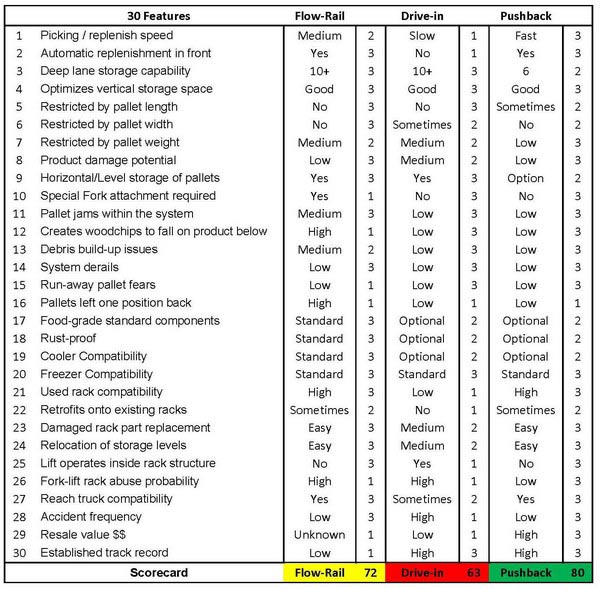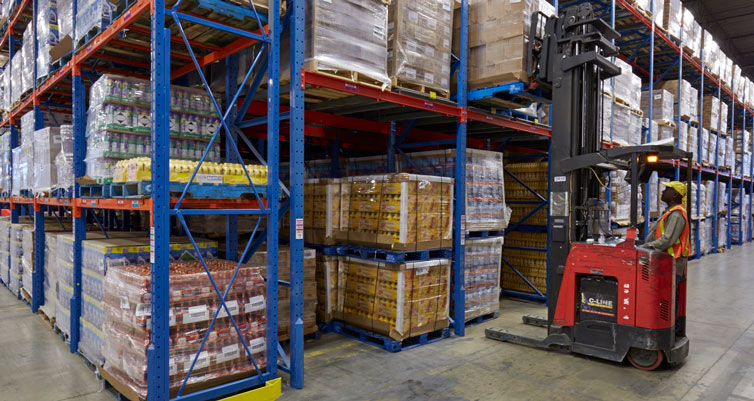Contrary to some of the literature out there, “Flow-Rail” is not a new high-density storage product.
Flow-Rail was first introduced to North America back in the early 1990’s by another Canadian distributor. The product had limited success – it was susceptible to jamming caused by wood chips created by the serrated chain on the wooden pallets. To our knowledge, not one of those installations are still in use today.
Based on past experience and current knowledge, we believe that pushback racking is a good alternative to using flow-rail products
We have offered a comparison chart below, along with some explanation for each of the points.

1) While we agree that Drive-in racks take longer to load or unload, pushback is generally faster to unload than Flow-Rail because the operator just lifts up the pallet and backs up. With Flow-Rail, the operator must tilt the pallet just right and then back out while maintaining pressure on the chain.
4) 3D’s low profile pushback rack system has roughly the same height profile as Flow-Rail. While pushback requires slope, no clearance is required at the back of a lane, and therefore there is no height disadvantage to using pushback.
5) Drive-in and Flow-Rail have no depth restrictions. Pushback can work with a variety of depths, but it must be designed that way right from the start.
6) Pushback applications have been designed for many different pallet widths. Both Flow-Rail and Pushback must place rails for narrowest pallet.
7) 3D’s pushback systems can work with any weight – we have 5000#/pallet systems out in the field
8) There are no issues with product damage while utilizing pushback racks – there are literally millions of pallet positions installed in North America with many repeat customers that would not accept the possibility of product damage.
9) Pushback can be designed with level carts if desired.
10) Flow-Rail requires the use of special attachments on the forks to allow them to “grip” the pallet when backing out.
11) Pallet jams from improperly placed pallets (placed too close to the side of the rack) are possible with both drive-in and Flow-Rail. Properly loaded pushback systems do not jam.
12) The serrated teeth on a Flow-Rail system creates many wood chips when pallets are being unloaded resulting in wood chips falling on product below.
13) The wood chips will also accumulate in the track over time and could cause jamming issues.
15) Because 3D’s pushback carts are linked together, you cannot have a runaway pallet.
16) If an operator lifts a pallet in a Flow-Rail system too high and then backs out he will leave the remaining pallets stuck one position back. This is not possible in pushback.
21) Pushback racks can be retrofitted into existing racks or used racks
26) Flow-Rail is made from an aluminum extrusion and the rails sit exposed on top of the load beam. It is secured to a roll formed beam with a few tek screws. This set-up is very susceptible to damage from forklifts. Pushback is made from robust structural steel and the rails are bolted in behind the structural steel load beam. It is significantly better at resisting forklift abuse.
29) There are no known installations left operating from the earlier projects in the 90’s. Most were dismantled over a period of several years after having issues with wood chips and jams. We have many pushback systems that are 20+ years old, still in use, or re-sold on the used market.
30) There is no comparison on the track record of pushback compared to Flow-Rail. As mentioned earlier, there are literally millions of pallet positions of pushback storage in operation in North America.
Please contact us if you have any questions or comments regarding our flow rail chain system comparison.

